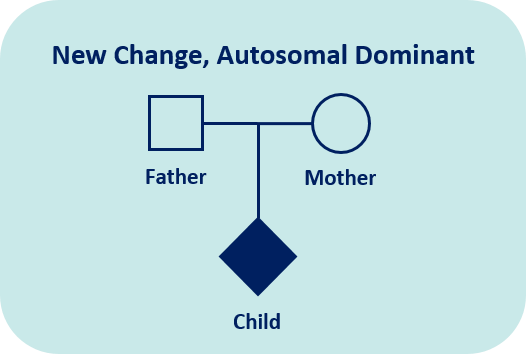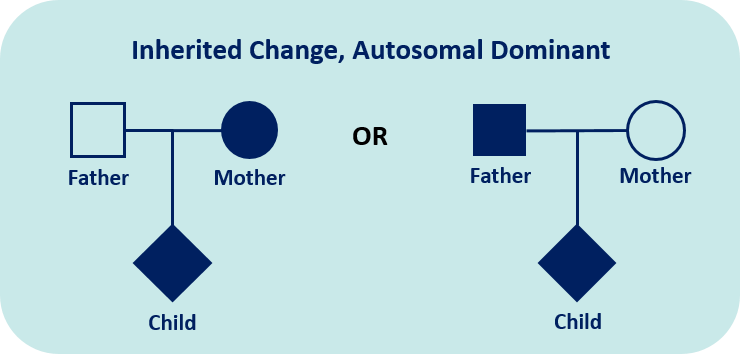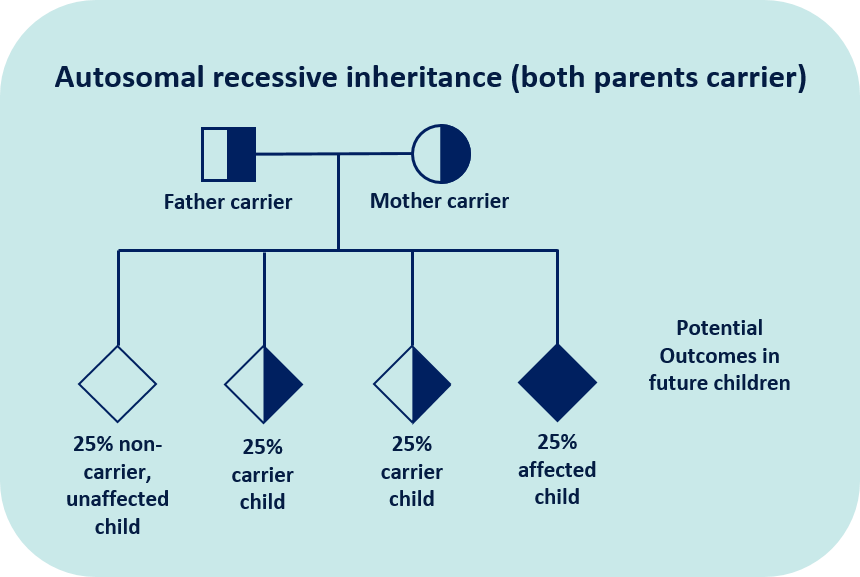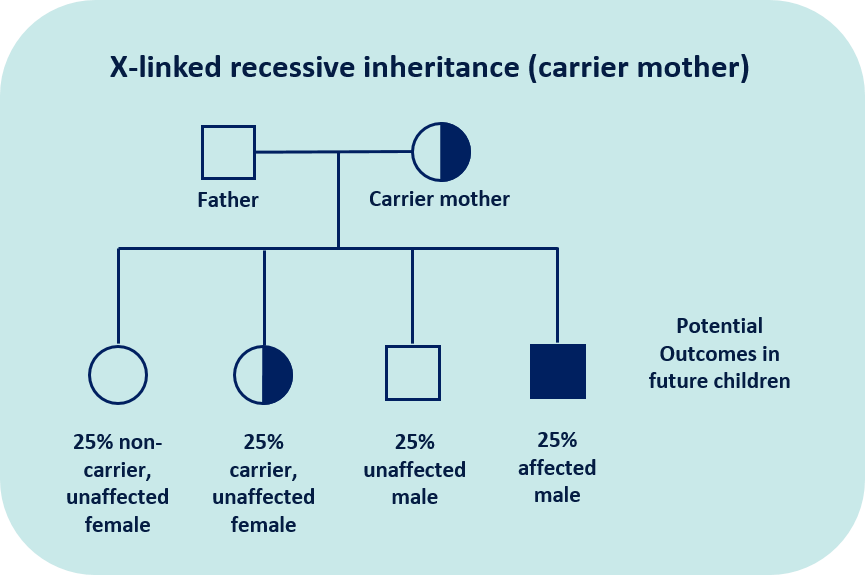The instructions that make us who we are (called genes) are carried in pairs. Genes are made up of thousands of molecules of DNA. DNA is made up of four units that are in a specific sequence within each gene. These genes are bunched together onto structures called chromosomes. We inherit one copy of each gene (and therefore each chromosome) from each of our parents. Additional information on DNA, chromosomes and genes can be found here.
A genetic epilepsy can occur in multiple generations in a family or be unique to one person and may cause different symptoms in different members of the same family. There are five main ways genetic epilepsies can occur in families detailed below (there are other rare exceptions that will not be explored here e.g. PCDH19 but can be explained by your genetics team).
1. A new genetic change in the affected person
- Inheritance:
- This type of change is genetic, but it is not inherited from the parents, who do not have epilepsy.
- This is called a ‘de novo’ (or new) change, resulting from a change in only one of the copies of our genes. The other copy is still working, but some particular genes require two working copies in order to provide instructions for general good health. This pattern of inheritance is called Autosomal Dominant inheritance. More details about this form of inheritance can be found here.
- Who is affected:
- This pattern of inheritance affects both males and females.
- Implications for family planning:
- Parents of a child with a de novo change have a low, but not zero, chance of having another affected child. This is because the genetic change may be present in a pocket of eggs or sperm (‘gonadal mosaicism’). This possibility can be discussed in more detail with your genetics specialist.
- There is a 1 in 2 (50%) chance that an affected person will pass the condition on to their future children.

2. An inherited genetic change from an affected parent
- Inheritance:
- This change has been inherited from a parent who also has the same condition.
- This is called ‘Autosomal Dominant inheritance’, resulting from a change in only one of the copies of our genes. The other copy is still working, but this particular gene requires two working copies in order to provide instructions for general good health. More details about this form of inheritance can be found here.
- Who is affected:
- This pattern of inheritance affects both males and females.
- Implications for family planning:
- There is a 50% chance that an affected individual will pass the condition on to their future children.

3. A combination of genetic changes from each parent
- Inheritance:
- These changes are inherited from the affected individuals’ parents, although the parents themselves will be unaffected.
- This is called Autosomal Recessive inheritance. As each parent has two copies of every gene, in their eggs or sperm, they only pass on one copy. One copy from each parent combines to create their child. Should the parents both carry a change in the same gene, the child is at risk of inheriting both changed copies and having the genetic condition. There is often no family history of the condition. More details about this form of inheritance can be found here.
- Who is affected:
- This pattern of inheritance affects both males and females.
- Implications for family planning:
- Parents of children with recessive conditions will have a 1 in 4 (25%) chance of having another baby with the same condition.
- Affected individuals will be unlikely to pass the condition on to their own children, but should have their partner screened prior to family planning (to avoid the low risk of a partner being a carrier).

4. A genetic condition that only affects males
- Inheritance:
- The condition may occur for the first time in an affected male, or may be inherited from a carrier female. There may be a family history of affected males or no family history at all.
- This is called X-linked recessive inheritance. The genes, which provide instructions to make a male or a female, are located on the X and Y chromosomes. Females have two X chromosomes and boys have an X and Y. If there is a change in a gene located on the X chromosome, females can carry one change and one working copy and be well and healthy (called a ‘carrier’). Males have only one X chromosome and therefore if they have a change in their X chromosome they will have the genetic condition. More details about this form of inheritance can be found here.
- Who is affected:
- This pattern of inheritance only affects males.
- Implications for family planning:
- Unaffected female carriers of these conditions have a 1 in 4 (25%) chance of having an affected boy.
- Males who have the condition cannot have an affected son (as they will pass their Y chromosome to their sons).
- Males who have the condition will pass their changed X chromosome to their daughters, making all their daughters carriers.
